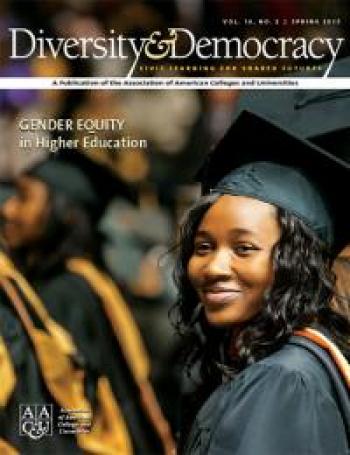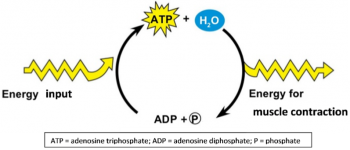Serendip is an independent site partnering with faculty at multiple colleges and universities around the world. Happy exploring!
education

Bryn Mawr College's TIDES Project featured in Association of American Colleges and Universities
Bryn Mawr College's TIDES Project (Teaching to Increase Diversity and Equity in STEM initiative) is featured in the new issue of AAC&U, Diversity & Democracy on Gender Equity in Higher Education, Spring 2015, Vol. 18, No. 2.
"This iss ue of Diversity & Democracy extends AAC&U's longstanding commitment to addressing gender-based inequities in higher education. Article topics include gender equity among STEM students and faculty, women's leadership in areas such as higher education administration, the role of women's colleges and universities worldwide, and the importance of creating campuses that are safe and inclusive for students of all gender identities."
ue of Diversity & Democracy extends AAC&U's longstanding commitment to addressing gender-based inequities in higher education. Article topics include gender equity among STEM students and faculty, women's leadership in areas such as higher education administration, the role of women's colleges and universities worldwide, and the importance of creating campuses that are safe and inclusive for students of all gender identities."
In Women in Computing: The Imperative of Critical Pedagogical Reform, the "Key to sustaining US global competitiveness is the country's ability to harness the kinds of diverse perspectives that not only are known to fuel better scientific outcomes, but also are associated with the inclusion of underrepresented groups, particularly women and women of color."
Kelly Mack and Melissa Soto, Association of American Colleges and Universities; Lilliam Casillas-Martinez, University of Puerto Rico–Humacao; and Elizabeth F. McCormack, Bryn Mawr College

Zine Workshop with artist Shing Yin Khor
On Wednesday, April 1st, artist Shing Yin Khor along with Professor Shiamin Kwa hosted a Zine Workshop in the new Carpenter Media Lab in conjunction with the East Asian Language and Culture course: Everything But the Table (EALC 345). The Carpenter Media Lab was a great new space for digital collaboration as the students quickly got to work making their own zines within one hour with art supplies scattering the tables.
Though much of Khor's work is printed or sculpted, the internet has become a gamechanger for artists like Khor. Through fundraising platforms like Patreon, artists of all kinds can create sponsorships where their fans can give monetary support in order to receive exclusive blog posts and updates as well as gifts and subscriptions. Furthermore, publishing platforms such as Issuu have made it easier to share zines and publications digitally.

Meet VoiceThread!
![]()
VoiceThread is a user-friendly way to share power point presentations, videos, photos, and other media. Students and professors can record video or audio responses, draw on the media to highlight certain points, and comment in text form. This site is useful for discussion outside of the classroom, allowing students to focus on the topic at hand and reflect in a collaborative way.

Want to Learn More?
Read how VoiceThread describes its capabilities.
/\/\/\/\/\/\/\/\/\/\/\/\/\/\/\/\/\/\/\/\/\/\/\/\/\/\/\/\/\/\/\/\/\/\/\/\/\/\/\/\/\/\/\/\/\/\/\/\/\/\/\/\/\/\/\/\/\/\/\/\/\/\/\/\/\/\/\/\/\
Capabilities
Through VoiceThread...
Professors can:
- Upload power points
- Upload question slides for comment
- Comment on students’ writing in video, text, and visual formats
Students can:

What is MediaThread?
 MediaThread, a project created by the Columbia Center for New Media Teaching and Learning through the Digital Bridges Initiative is a service that allows you to blend your thoughts with multimedia sources and share them with others. MediaThread supports video, images, metadata, and many content websites listed below. Most compatible with Firefox, MediaThread is currently being used by Columbia, MIT, Wellesley, Dartmouth, The American University in Cairo, and many other institutions of higher education.
MediaThread, a project created by the Columbia Center for New Media Teaching and Learning through the Digital Bridges Initiative is a service that allows you to blend your thoughts with multimedia sources and share them with others. MediaThread supports video, images, metadata, and many content websites listed below. Most compatible with Firefox, MediaThread is currently being used by Columbia, MIT, Wellesley, Dartmouth, The American University in Cairo, and many other institutions of higher education.
Who can do what with MediaThread? Through MediaThread...

Final Web Event - Addressing Inclusiveness at Home at Bryn Mawr: A Seminar
Bryn Mawr is my home.
That one phrase is so much more than the five words it contains. Now more than ever before. To me, a home is much more than four walls or a campus. Bryn Mawr is home to me because of its people, because of its community. It is here that I have become comfortable with who I am - my sexuality, my past, my life.
When I first began to think about this final paper, I knew I wanted it to be about this place that means so much to me. Bryn Mawr. I also wanted to incorporate in parts of my other papers. As I reflected over my work and growth in this course, I realized I left my third paper open ended without a firm direction in terms of education for Wabash. During conversations (usually over food) with my friends, I began to see that Bryn Mawr also needs a new form of education. An education in inclusion. I began to think of my second paper on the inclusiveness/discrimination of the straight community within Bryn Mawr's community. I concluded Bryn Mawr needs an intervention.

Fear of Feminist Indoctrination at All-Men's Colleges
The phrase "feminism unbound" is strange to me. I thought at first I understood it, but when we began to discuss this phrase in class, I got even more confused. So I sat down to think about it on my own. I thought about the rigors of society, the boundaries have set for ourselves and others, the world we have been told should exist. As someone who has chosen to go to an all-women's college I know I follow certain boundaries within the walls of Bryn Mawr College, regulations the college sets for me. I began to think of similar institutions. A friend of mine also goes to a single-sex institution, Wabash College, an all-men's college in Indiana. Wabash sets regulations for its students as well. A potential new regulation is a gender studies graduation requirement. This debate struck a chord with me, especially when I discovered the contorted view of gender studies some members of the institution had created around this issue . . .
"[The] wimpy, neutralized guys that gender feminists are trying to create: men who are not committed to constructive struggle and conflict and fighting for a cause and coming out the winner." (Michaloski and Allman) This statement was made by Dr. David P. Kubiak, a Classics professor at Wabash College in relation to the debate at Wabash over the proposition of a gender studies graduation requirement.


 In this analysis and discussion activity, students develop their understanding of photosynthesis by answering questions about three different models of photosynthesis.
In this analysis and discussion activity, students develop their understanding of photosynthesis by answering questions about three different models of photosynthesis.


